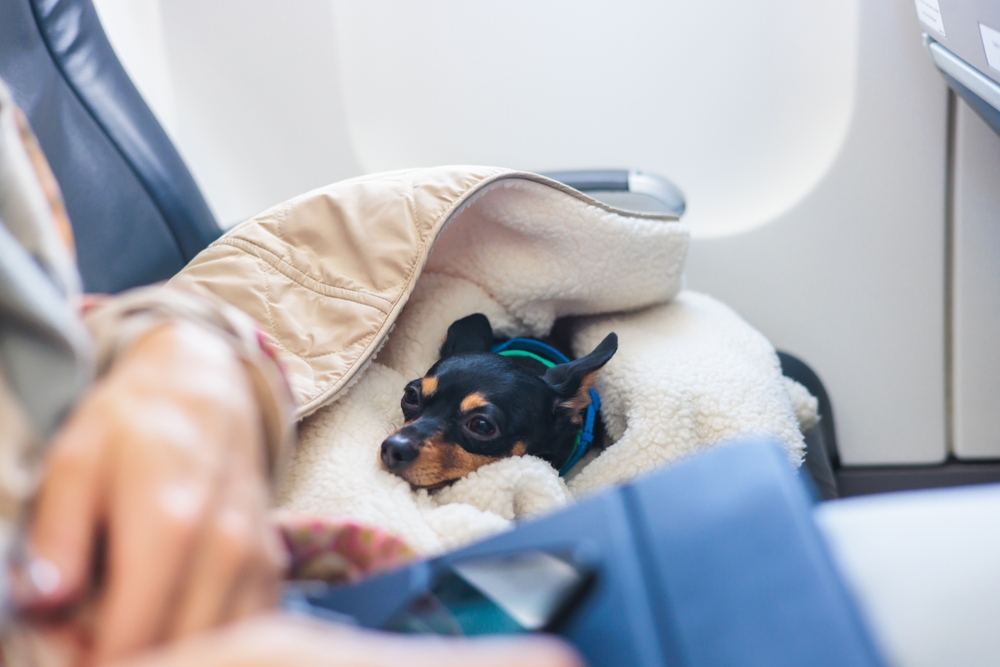Airline to Allow Cats and Dogs To Fly In Cabins Alongside Owners

Imagine being told that your best friend—your loyal dog or affectionate cat—must travel miles away from you in the cargo hold while you soar above the clouds. For years, this was the reality for pet owners, a bittersweet trade-off for the joy of bringing their furry companions along for the ride. But now, things are changing. Airlines are finally acknowledging that pets aren’t just animals—they’re family.
In a groundbreaking move, airlines are opening their cabin doors to four-legged passengers, allowing cats and dogs to sit alongside their owners mid-flight. This shift doesn’t just redefine how we travel; it reflects a growing recognition of the deep emotional bond between humans and their pets. With more than 60% of households in the U.S.

The Policy Shift: A New Era for Pet-Friendly Travel
For decades, air travel has been a challenge for pet owners. While some airlines allowed small pets in carriers under seats, many required beloved companions to be stowed away in cargo—a stressful, often traumatic experience for both animals and their owners. But a growing demand for more compassionate travel options has spurred a significant policy change: airlines are now allowing cats and dogs to accompany their owners in the cabin.
This shift is more than just a convenience; it’s a reflection of societal changes. Today, pets are seen as family members, not just animals. By enabling owners to keep their pets close during flights, airlines are addressing the emotional and physical well-being of both. This progressive policy not only makes air travel less daunting for pet owners but also aligns with the increasing global emphasis on humane treatment for animals.
Furthermore, this change isn’t happening in isolation. It’s part of a broader trend where businesses are adapting to meet the evolving needs of modern pet-loving households. For frequent flyers with furry friends, the cabin is finally becoming a place where everyone feels at home.
Benefits for Pets and Owners
The decision to allow pets in airline cabins goes beyond convenience—it’s about fostering a more humane travel experience. For years, pet owners faced a difficult choice: either leave their beloved companions behind or subject them to the stress of cargo travel. Cargo holds, while temperature-controlled, can still be noisy, disorienting, and overwhelming for pets. This often left owners feeling helpless, worried about the well-being of their furry family members during long-haul flights.
With pets now permitted to travel in cabins, the emotional benefits are immense. For pets, being close to their owners provides a sense of comfort and security in an unfamiliar environment. Dogs and cats, like humans, experience anxiety, and being separated from their trusted companions only amplifies their stress. Traveling in the cabin minimizes this anxiety, creating a calmer and safer experience for the animal.
For owners, this policy change offers peace of mind. Knowing that their pet is just a seat or row away removes the constant worry that comes with cargo travel. Beyond the emotional comfort, it also allows pet parents to keep an eye on their pets’ behavior and needs, ensuring they are well-adjusted and comfortable throughout the journey. This shared proximity not only strengthens the bond between pets and their owners but also turns what was once a stressful experience into an opportunity for connection and care.
In essence, this change acknowledges that pets are more than just animals—they’re companions, emotional anchors, and, for many, an integral part of the family. By bringing them closer during travel, airlines are responding to the heartfelt desires of pet owners worldwide while ensuring the safety and well-being of their cherished companions.

Image Credits: Virgin Australia
The Rules and Limitations
While this policy change is a welcome relief for pet owners, it comes with specific rules and limitations to ensure a balanced travel experience for everyone on board. Not all pets qualify for cabin travel, as airlines have established guidelines that prioritize safety, comfort, and practicality.
One of the primary requirements is the size and weight of the pet. Most airlines allow only small dogs and cats that can fit comfortably in an approved carrier under the seat in front of the owner. This ensures the pet remains secure and does not obstruct movement in the cabin. Additionally, the carrier must meet specific dimensions and ventilation standards to provide the pet with adequate space and airflow during the flight.
There are also breed-specific restrictions in place. For instance, many airlines prohibit brachycephalic breeds like pugs or Persian cats, which are prone to respiratory issues, especially in high-altitude environments. These measures are designed to protect pets’ health and safety, even if they limit certain owners from bringing their pets onboard.
Fees for pet travel in cabins vary across airlines and are often charged as an additional cost per flight segment. Owners must also make prior arrangements, as space for pets in cabins is typically limited. Some airlines require advance reservations to secure a spot, ensuring that only a manageable number of pets are in the cabin at any given time.
These rules, while restrictive in some cases, strike a balance between accommodating pet owners and ensuring the comfort and safety of all passengers. They also reflect the airlines’ efforts to create a pet-friendly environment without compromising the overall travel experience. For pet owners, understanding and adhering to these guidelines is an essential part of making this new travel option a smooth and enjoyable experience.
Real-Life Stories: Impact on Pet Owners
The shift toward allowing pets in airline cabins has profoundly impacted travelers, offering both convenience and emotional relief. For instance, a traveler recounted a 14-hour Cathay Pacific flight from Hong Kong to Barcelona, where they were seated next to Vinny, a black service dog. The presence of Vinny not only provided comfort but also made the long journey more enjoyable, highlighting the positive experiences that can arise from accommodating pets in the cabin.
In another example, Bark Air, a luxury airline dedicated to dogs, has been established to cater specifically to pet owners who wish to travel alongside their canine companions. This service underscores the growing demand for pet-friendly travel options and the lengths to which some are willing to go to ensure their pets’ comfort during flights.
These real-life accounts demonstrate the significant impact of pet-friendly policies on travelers, emphasizing the importance of accommodating the bond between owners and their pets during air travel.
Expert Perspectives: Advocates for Pet-Friendly Travel
The growing trend of allowing pets in airline cabins has sparked conversations among animal welfare advocates, veterinarians, and travel experts, many of whom champion the change as a step forward for humane treatment. These professionals emphasize the importance of ensuring the emotional and physical well-being of pets during travel, highlighting how cabin policies align with best practices in animal care.
Dr. Sarah Edwards, a veterinary behavioral specialist, notes that “separation anxiety is a major concern for many pets during travel. Allowing them to stay with their owners in the cabin can drastically reduce stress levels, making the journey more comfortable for both the pet and the owner.” This perspective resonates with pet owners who have long sought alternatives to the isolated and potentially distressing conditions of cargo travel.
Animal welfare organizations have also supported the shift, viewing it as an acknowledgment of the deep bond between humans and their pets. Organizations like the Humane Society have stated that enabling cabin travel minimizes the risks associated with cargo holds, such as extreme temperatures or mishandling, which have previously led to tragic incidents.
Travel experts highlight how this change reflects broader trends in the travel industry, where personalization and customer-centric policies are becoming priorities. According to Chris Allen, a travel consultant, “The decision to allow pets in cabins isn’t just about meeting a demand; it’s about redefining the travel experience to include the needs of modern families—pets included.”
By incorporating the insights of experts, the new policies signal a more compassionate approach to pet travel, aligning with the growing understanding of pets’ emotional needs and the evolving expectations of pet-loving travelers. This shift demonstrates how thoughtful adaptations can foster a more inclusive and humane travel experience for all.
Challenges and Concerns
While the shift to pet-friendly airline cabins has been widely celebrated, it also brings a set of challenges and concerns that airlines must address to balance the needs of all passengers. One of the most frequently cited issues is the potential for allergies among passengers. Some individuals have severe reactions to pet dander, and the confined space of an airplane cabin could heighten their discomfort or pose health risks. To mitigate this, airlines have implemented measures such as limiting the number of pets per flight and assigning specific seating areas to pet owners.
Another concern revolves around space constraints in cabins. The addition of pet carriers, which must be placed under seats, can reduce legroom and comfort for nearby passengers. This issue is particularly pressing on full flights where space is already at a premium. Airlines are working to strike a balance by enforcing strict size requirements for carriers and ensuring that pets remain contained throughout the journey.
Behavioral challenges also come into play. Even well-trained pets can become restless or anxious during a flight, leading to potential disturbances for other passengers. Airlines address this by requiring pets to be in approved carriers and encouraging owners to consult veterinarians for tips on calming their animals before traveling.
Loading...






